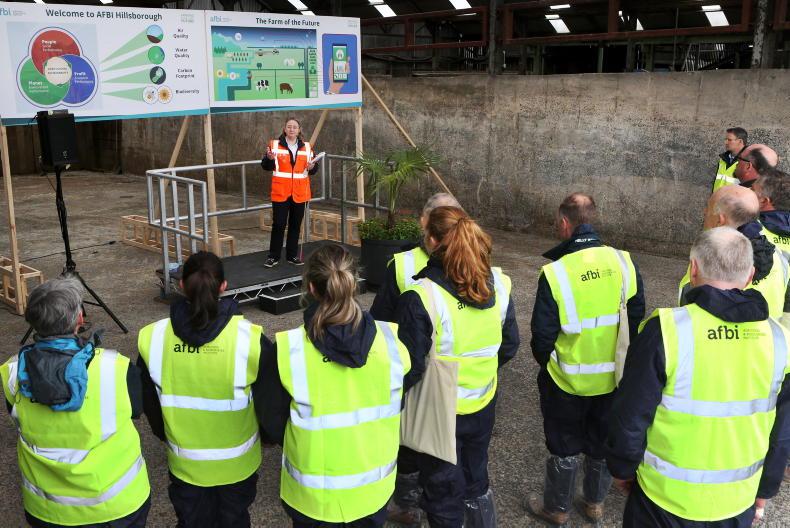An analysis of bovine TB data has found that the average TB breakdown in NI lasts 226 days, which equates to seven and a half months.
Researchers from the Agri Food and Biosciences Institute (AFBI) analysed data from 7,473 breakdown incidents in NI over a six-year period.
They found that almost half of all breakdowns lasted less than six months, 35% were between six and 10 months, 11% lasted 10 to 14 months, and 6.6% of breakdowns ran on for more than 14 months.
The average breakdown length varied across the 10 Divisional Veterinary Office areas (DVO) in NI, ranging from 192 days in Derry to 266 days in Newry.
The study, published in the scientific journal PeerJ, found that numerous factors were associated with TB breakdown duration.
The strongest association was seen in the number of different TB strains observed within a breakdown herd. This is most common in beef finishing units where cattle are bought in from a large geographical area, resulting in a wider range of TB strains within the herd.
Within five DVO areas, increased sett density was associated with longer breakdowns. But in the other five DVO areas, the opposite trend was seen
The AFBI scientists also found that larger herds tended to have longer TB breakdowns.
Other factors included the number of reactors found in the first TB-positive herd test and when lesions are found in animals at slaughter.
“The presence of a tuberculosis lesion is often evidence of undetected TB infection within the herd,” the research paper reads.
These issues mainly stem from slow progress in clearing TB infections within herds, and the researchers point out that the low sensitivity of the skin test can be a contributing problem.
The study also found that other factors associated with the length of TB breakdowns include the prevalence of TB in the local area and the level of interaction between cattle from different herds, whether it is shared housing, grazing or use of handling facilities.
Badger setts
The AFBI researchers also investigated the relationship between badger sett density in local areas and TB breakdown duration, although the results were unclear.
Within five DVO areas, increased sett density was associated with longer breakdowns. But in the other five DVO areas, the opposite trend was seen.
However, the scientists point out that sett density provides no insight into TB incidence within the local badger population, and sett density does not always correspond to badger numbers, as some setts are more populated than others.
Read more
Lifetime assurance planned for 2023
Plans to ramp up BVD measures in NI
An analysis of bovine TB data has found that the average TB breakdown in NI lasts 226 days, which equates to seven and a half months.
Researchers from the Agri Food and Biosciences Institute (AFBI) analysed data from 7,473 breakdown incidents in NI over a six-year period.
They found that almost half of all breakdowns lasted less than six months, 35% were between six and 10 months, 11% lasted 10 to 14 months, and 6.6% of breakdowns ran on for more than 14 months.
The average breakdown length varied across the 10 Divisional Veterinary Office areas (DVO) in NI, ranging from 192 days in Derry to 266 days in Newry.
The study, published in the scientific journal PeerJ, found that numerous factors were associated with TB breakdown duration.
The strongest association was seen in the number of different TB strains observed within a breakdown herd. This is most common in beef finishing units where cattle are bought in from a large geographical area, resulting in a wider range of TB strains within the herd.
Within five DVO areas, increased sett density was associated with longer breakdowns. But in the other five DVO areas, the opposite trend was seen
The AFBI scientists also found that larger herds tended to have longer TB breakdowns.
Other factors included the number of reactors found in the first TB-positive herd test and when lesions are found in animals at slaughter.
“The presence of a tuberculosis lesion is often evidence of undetected TB infection within the herd,” the research paper reads.
These issues mainly stem from slow progress in clearing TB infections within herds, and the researchers point out that the low sensitivity of the skin test can be a contributing problem.
The study also found that other factors associated with the length of TB breakdowns include the prevalence of TB in the local area and the level of interaction between cattle from different herds, whether it is shared housing, grazing or use of handling facilities.
Badger setts
The AFBI researchers also investigated the relationship between badger sett density in local areas and TB breakdown duration, although the results were unclear.
Within five DVO areas, increased sett density was associated with longer breakdowns. But in the other five DVO areas, the opposite trend was seen.
However, the scientists point out that sett density provides no insight into TB incidence within the local badger population, and sett density does not always correspond to badger numbers, as some setts are more populated than others.
Read more
Lifetime assurance planned for 2023
Plans to ramp up BVD measures in NI









SHARING OPTIONS